|
In this guide, we take a look at what you need to know when partnering with a commercial glass company.
|
IN A RUSH?Download a copy of this guide to read later: |
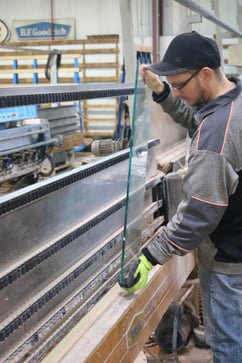
Crafting Clarity: Guide to Partnering With a Commercial Glass Company
Building your dream project in glass requires more than just a vision—it’s a partnership built on clear communication and shared understanding. Imagine having a masterpiece in your mind, but the craftsmen never hear the details. The result? A creation that falls short of your expectations.
Whether you imagine a stunning commercial storefront, an elegant hotel lobby, or a luxurious shower enclosure, partnering with a commercial glass company is key to transforming that vision into reality. But it's not just about handing them a sketch; it's about communicating every detail so they can bring your ideas to life with precision and artistry.
This guide is your roadmap to a successful partnership with your commercial glass company. It dives into the essential steps, communication strategies, and design considerations that confirm your project looks spectacular and stays on track, on time, and budget. From the first idea to the last installation, we'll reveal the keys to a smooth working relationship that delivers a finished product beyond your expectations.
Whether you’re designing a commercial storefront, a hotel lobby, or a shower enclosure, your commercial glass company is a great partner. However, your vision needs to be presented to your glass company in a way that makes your vision come to life just the way you imagined it.
Partnering with a commercial glass company involves a lot. This guide walks you through the ins and outs of this partnership so that your project looks great, is completed on time, and does not break your budget.
Precision Glass Crafting: Capabilities That Set the Standard
"The glass manufacturer you choose should be able to provide basic fabrication capabilities that save your project from unnecessary delays, cost overages, and headaches."
Choosing the proper glass manufacturer can streamline your project and avoid inefficiencies. A single manufacturer can handle all aspects of glass fabrication, including edging, v-grooving, and CNC grinding, making it more cost-effective and time-efficient. The glass manufacturer you choose should be able to provide basic fabrication capabilities that save your project from unnecessary delays, cost overages, and headaches coordinating with multiple suppliers.
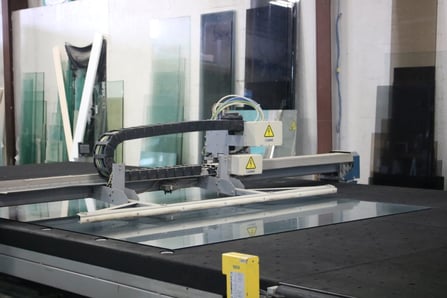
Five capabilities that your commercial glass company should provide:
- Working small
- Advanced mitering/edging
- Water jet capabilities
- V-grooving
- CNC machining
1. Working Small
Your project may involve pieces of glass that are only a few inches in size, whether for manufacturing trophies or placing accents in larger glass pieces. Your glass fabricator should be able to work with sizes large and small.
2. Advanced Mitering/Edging
Can your glass fabricator cut glass at any angle? Advanced mitering and edging capabilities are necessary for custom-designed pieces or those with non-geometric shapes. The best fabricators are skilled enough to miter a unique piece of glass as quickly as in a standard 90-degree shower.
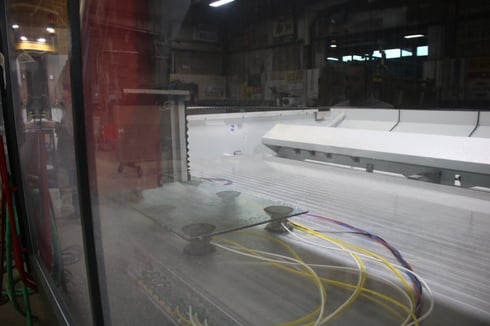
3. Water Jet Capabilities
Your glass fabricator should have water jet capabilities for those times when you need precise and intricate cuts, including:
- Cutouts
- Custom designs
- Desktops
- Glass walls
- Mirrors
- Switchplates
4. V-Grooving
Does your project involve detailed patterns? Your customer may want to match a certain time period or an eye-catching design for an upscale restaurant. Your vendor should have v-grooving capability to meet their design vision.
V-grooving cuts v-shaped lines into the surface of a glass pane to create detailed patterns. V-grooving can be applied anywhere on a glass pane.
5. CNC Machining
Does your glass need to meet exact specifications for shape and size? Are there minor flaws that need to be addressed? Your glass fabricator should have CNC machining capabilities to fabricate glass to precise measurements and within acceptable tolerances.
A Clear View: Designing Effective Sketches for Glass Fabrication
"Precise sketch measurements ensure your glass manufacturer efficiently
and accurately completes your job."
Your manufacturer shouldn’t have to struggle to understand the details of a sketch or template, nor should they have difficulty using it to craft the final product. Precise sketches provide a smooth fabrication process and confirm that the final output matches your needs. This clarity removes any room for error to speed up production, guaranteeing your project stays on track and meets its intended deadlines.
There are many details your partnered glass company needs to know about your project. The key to creating a usable template sketch for a commercial glass manufacturer is two-fold:
- Accurate measurements
- Presentation
1. Accurate Measurements
Your sketch is simply a picture of what you want without exact measurements. But is the piece 8’x12’ or 4’x6’? What tolerances are required? How thick should the glass be?
Precise sketch measurements ensure your glass manufacturer efficiently and accurately completes your job. They also guarantee that the finished product fits perfectly where it’s supposed to—even with uncommon shapes, such as parallelograms or pieces with unique dimensions.
.jpg?width=496&name=img-blog-angledmeasurements%20(1).jpg)
- Side lengths
- Heights
- Thicknesses
- Block sizes
- Offsets
- Inside radius (if known)
- Tracing of questionable areas may be required
- Tolerances
2. Presentation
Don’t send your vendor a scribble on a napkin. To ensure your manufacturer gives you exactly what you want, your sketch should have clearly defined lines and the precise locations of any cutouts, notches, or hardware. Pictures of the space where the glass product will be installed are also helpful but not necessary for glass walls, windows, or shower enclosures.
Sketches are best provided to manufacturers on single pieces of:
- Cardboard
- Wood
- Heavy paper
- Digital files such as DXF or PDF
Don’t send sketches on:
- Wrapping paper
- Newspaper
- Plastic sheets

Defining Details: Constructing Templates for Commercial Glass Companies
"Make sure your sketches and templates give all the details your vendor needs."
Your project may involve some unique shapes that make it challenging to provide a detailed sketch. A template helps communicate what you’re looking for. This tool bridges the gap between conceptual ideas and physical creation, ensuring the manufacturer perfectly captures and understands your vision.
The most important thing about your pattern template is that it must be the exact size and shape of what you want to fabricate.
Templates must:
- Be on a single piece of wood, cardboard, or heavy paper
- Feature thin, distinct lines
- Denote where the edge of the pattern is in relation to lines -- is the edge on the inside, outside, or center of the line?
- Not be cut to the object’s exact shape
Communication is key for your glass manufacturer to deliver the product you were hoping for. Make sure your sketches and templates give all the details your vendor needs.
5 Key Design Details For Your Custom Glass Project
"Getting glass design details right saves you time, money, and frustration.
You want glass products that are easy to install, not a source of frustration."Getting glass design details right saves you time, money, and frustration. You want glass products that are easy to install, not a source of frustration.
Fabrication Elements That Impact Commercial Glass Manufacturability
Don’t leave the details to chance. Paying attention to these five details during the design stage allows your commercial glass manufacturer to fabricate beautiful, custom-shaped pieces that meet your project’s demands.
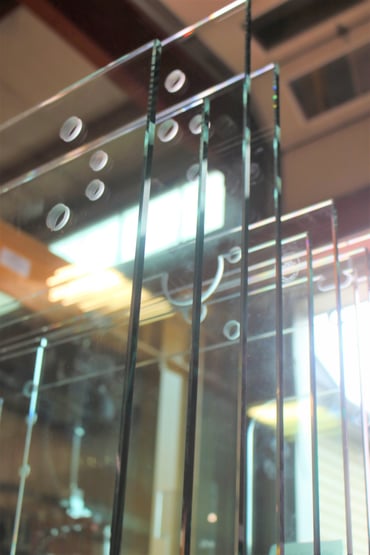
- Shape
- Size
- Holes
- Cutouts
- Edgework
1. Shape
Your project may involve some non-traditional shaping. It’s important to let your glass manufacturer know this upfront. Your design may require skills beyond their capabilities. Telling them in advance allows you to make other arrangements if necessary.
Creating a quality template or pattern is necessary to ensure you and your glass manufacturer are on the same page. Consider sending a digital photo of where the glass will be installed, especially for irregular-shaped glass, such as pieces for slab furniture.
2. Size
Make sure to connect with your commercial glass manufacturer regarding size limitations. Not all glass manufacturers have the same equipment. This is especially true for large glass pieces that cannot be fabricated in a single unit. A 20’ x 20’ wall mirror, for example, may need to be created in multiple pieces.
3. Holes
This is particularly important with tempered glass, as holes need to be made in the glass before it’s tempered. The minimum hole diameter needs to be equal to the glass pane’s thickness. The placement of a hole in a tempered glass piece can’t be too close to a corner or edge because it becomes nearly impossible to fabricate as specified. A slotted hole may be required when the hole is too close to the edge.
4. Cutouts
This applies mainly to single glass pieces with large cutouts, such as a bathroom mirror with an opening for an inset medicine cabinet. Remember: there are limits with the cutout/glass pane size proportions -- the larger the cutout, the more risk there is for breakage.
5. Edgework
The thickness of your glass impacts the style of edgework you can use. Again, there are manufacturer limitations.
At New Angle Beveling, an ogee edge is only available on ½″ and ¾″ thick glass, while a bullnose edge is ½”. The triple pencil edge (waterfall) can only be completed on ¾” glass.
Bridge the Gap: Clear Communication for Flawless Glass Fabrication
Do all that you can to get you and your manufacturer to understand one another.
Designing a glass piece that meets a custom glass service company’s capabilities is only half of creating a manufacturable project. The other half involves detailed planning and coordination that aligns your design with any logistical and manufacturing limitations. This ensures the final product is feasible within the manufacturer’s capabilities.
The other is communicating precisely what you expect of the finished product.
You’ll want to tell your glass manufacturer precisely what you plan to use the glass for. Give them all the details -- from size to tolerances. Do all you can to get you and your manufacturer to understand one another. This reduces the time you play telephone tag and ensures you get the right product the first time.
You may need to become an expert in glasswork. Ask questions and be open to recommendations. The more you understand, the easier the process is.
9 Project Details Your Commercial Glass Company Should Know
"Good information means good results."
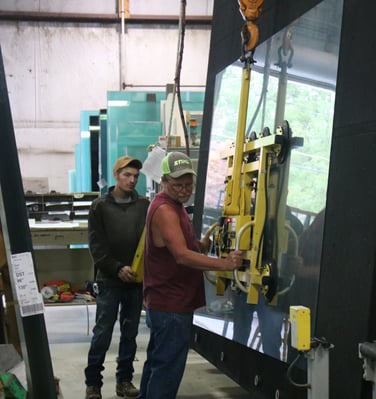
When working with a commercial glass company, here are nine things they’ll need to know before starting your project:
- Project scope
- Budget
- Deadline
- Dimensions
- Cutout/Hole information for hardware requirements
- Packaging
- Delivery location
- Shop limitations
- Tolerances
1. Project Scope
Every project has an ideal glass type. Your commercial glass company has expertise in this area. They need to know exactly how the glass will be used in your project so they can select the right type.
2. Budget
You may be shy about giving exact figures. You don’t want unnecessary upcharges or add-ons. A reputable commercial glass company isn’t interested in selling you what you don’t need. They want to help you make the best, cost-effective decisions possible.
Knowing how much you can spend, a glass company can provide you with the best information and products possible. They can also give you a realistic expectation of your project’s cost. You may have underestimated the price necessary to complete your project.
3. Deadline
Projects have many moving parts. A contractor must juggle several schedules to ensure projects are completed on time. Third-party elements, like commercial glass companies, need to know your deadlines, but you also need to know their capabilities.
Depending on its type or order size, the commercial glass for your project may require more time to manufacture. A glass manufacturer may need to make special arrangements to meet your timetable.
4. Dimensions
Give your glass manufacturer exact dimensions and shapes. Imprecise measurements mean you’ll get a custom-fabricated glass that won’t work with your project. The manufacturer works with the information you give them, and good information means good results.

5. Cutout/Hole Information for Hardware Requirements
Do you need hardware for your glass project? Glass companies need to know this upfront, especially if you want an accurate quote.
This information must be known when working with tempered glass, as fabrication must happen well before a pane is heat-treated.
Sometimes, custom glass sheets need holes or notches cut in to accommodate the hardware. These elements impact the glass manufacturing process. Knowing hardware requirements is especially important if specialized cuts are required.
6. Packaging
You want to make sure your glass remains intact as it travels from the commercial glass services company to your destination. You also want to make sure that the glass stays safe on location until it’s ready to be installed.
Let your manufacturer know of any special packaging requirements.
7. Delivery Location
The ordered glass may be delivered to your shop or the project’s location. The commercial glass manufacturer needs to know where the glass needs to go. This is especially important for deliveries going to more significant job sites where it’s easy to get lost.
8. Shop Limitations
Like commercial glass companies, your shop also has limitations. You may be limited by door height or the lack of people available to help lift the glass. You need to be prepared to receive your order.
9. Tolerances
Glass measurements need to be exact. A fraction of an inch may be enough to make a piece of glass not fit the intended space. Providing tolerance information ensures you’ll still receive a usable piece of glass or custom glass sheet, even if it needs additional work to clean up imperfections.
Don't Let Small Errors Shatter Your Vision: Your Guide to Glass Fabrication Tolerances
"Manufacturing tolerances are the wiggle room a glass piece has so that it can still fit and function as intended."
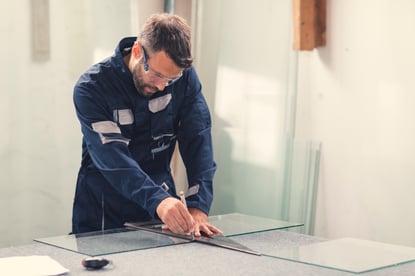
Though glass tolerances are among the most minor elements of glass fabrication, they can significantly impact the quality of a finished piece.
Failure to discuss glass fabrication tolerances could result in getting a glass piece that won’t work for your project.
What Are Tolerances in Commercial Glass Manufacturing?
Commercial tolerances are the minimum and maximum variations from a piece’s original measurements before it becomes unusable. In other words, manufacturing tolerances are the wiggle room a glass piece has so that it can still fit and function as intended.
Check out this resource to learn more about glass tolerances:
What to Tell a Commercial Glass Manufacturer About Your Project’s Tolerances
When partnering with a commercial glass manufacturer for standard glass fabrication, there are several pieces of information you should always provide:
- Dimensions: Length, width, and thickness.
- Edgework: Thickness, piece size, width-to-height ratio.
- Holes and notches: The location and placement tolerances for holes or notches are based on the width of the glass, radius, diameter, and chip tolerance.
- Tempering: Thickness, size, diagonal dimension, bow, and warp allowances.
Tolerance Information for Specialty Custom Fabricated Glass
Intricately shaped pieces like patterned and shaped glass may have tight or non-existent tolerances. Discussing this information with a glass manufacturer during the quoting process is critical. Creating glass pieces with little room for size deviation requires additional planning and labor, impacting final production costs.
Quality Renderings = Tolerance Accuracy
Renderings can be a glass manufacturer’s best friend in both quoting and completing a project.
When drawings are required to highlight specific fabrication details, submit clear and detailed sketches, complete with all required tolerance information. This is especially critical when projects have tight or no tolerances.
Every drawing submitted should be labeled to ensure the finished piece you receive is the same as the one you intended to order.
For bigger custom glass pieces or those requiring a template, a digital rendering is best, though traditional renderings are acceptable.
Large patterns submitted on taped-together paper leave room for error -- if a piece comes off or moves slightly, a glass manufacturer will likely struggle to put it back together exactly as before.
When it is time to finalize an order, submit the most recent version of your project’s rendering. That ensures a glass manufacturer is working with the most up-to-date information.
Be sure that your rendering includes any notes regarding specialty glass, such as the need for it to be heat strengthened. Any fabrication will need to be done before the glass is heat-treated.
Unbreakable Beauty: Why Tempered Glass is the Smart Choice for Safety and Style
"It’s best to talk with the manufacturer about current lead times to shape and temper a piece of glass."
Tempering glass requires heating a glass pane using high temperatures and then putting it through a high-pressure cooling process.
This procedure deliberately places stress on the glass. This stress produces tension that is compressed and spread to the outer edges of the glass, giving panes their final strength.
Why Use Commercial Tempered Glass?
Tempered glass is a popular choice as a shaped glass because of its three main characteristics:
- Strength: It’s one of the strongest glass types available.
- Safety: It breaks into pebble-like pieces instead of jagged shards, limiting the risk of serious injury.
- Heat resistance: It withstands higher temperatures longer than most glass.
Key Information for Tempered Glass Design Shapes
Here’s what you’ll need to provide to your glass fabricator:
- Glass Type
- Detailed Renderings
- Edgework
With the necessary information, glass fabricators quickly create your custom-shaped tempered glass. Production time can vary based on the complexity of work and work already scheduled for other customers. It’s best to talk with the manufacturer about current lead times to shape and temper a piece of glass.

Size Considerations for Mirror and Glass Sheets
You’ll want to consult your glass fabricator at the start of your process to determine the minimum and maximum sizes they have available. Each fabricator has different capabilities and constraints, so they’ll have different limitations on the size of glass they can use for your project.
The minimum and maximum glass sizes are determined by:
- Which glass type do you need?
- Are specialized shipping and handling equipment available?
- What size glass does the primary manufacturer have available?
- Are there limitations to the fabricator’s equipment?
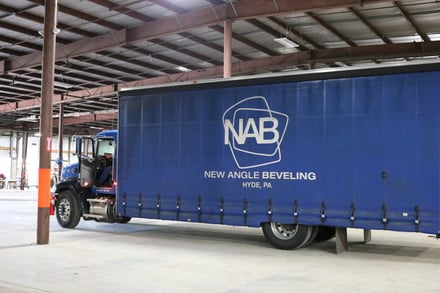 How To Safely Shipping Custom Glass Sheets
How To Safely Shipping Custom Glass Sheets
As a glass shop, the last thing you want is an unsatisfied consumer because their product is broken or damaged upon receipt. You know that glass is fragile, so take the precautions you need to ensure your glass arrives undamaged.
How Product is Shipped by Your Custom Glass Manufacturer
- Out-of-State Shipping: Commercial glass companies may choose a common carrier based on reviews or your preference. They will likely create the glass using foam between the wood and the glass and ample packaging material within. Paper interleaving prevents the glass pieces from rubbing and scratching against one another while in the crate.
- Local Shipping: Commercial glass companies may crate glass for local delivery. Alternatively, they could be placed on an L-Buck and offloaded with a forklift if there is substantial size and weight. Glass should be wrapped in cardboard with rubber material protecting the corners. Smaller fabricated products and orders shipped locally are often wrapped or shipped “loose” using static cling cork tabs in between. Whenever possible, ship glass products in covered trucks to protect fabricated glass from the elements.
3 Do’s of Custom Glass Shipping
|
3 Don’ts of Shipping Custom Glass
|
Commercial Mirror & Glass: Tips for Proper Handling, Installation & Upkeep
"Taking the proper precautions to protect your glass pieces, as well as your staff and customers, is worth the time and effort."
Commercial mirrors and glass should be handled with care. Carelessly moving, installing, or maintaining commercial mirrors or glass can break the piece or cause injury.
Taking the proper precautions to protect your glass pieces and your staff and customers is worth the time and effort.
Receiving & Storing Commercial Mirrors & Glass Sheets
Once the manufacturer sends the glass to you, it’s up to you to protect it. When your delivery comes, be sure to:
- Inspect it for obvious breaks while still in its packaging. If your order was damaged during shipping, you’ll save yourself the headache of cleaning up shards of broken mirrors.
- If moisture is present on the mirror or glass sheet, wipe it off with a dry cloth to preserve its integrity.
- Keep your commercial mirror or glass in a dry, well-ventilated area with a stable temperature to help preserve its integrity.
- Store your glass vertically. Laying it flat increases the risk of damaging your glass.
How to Safely Move a Large Mirror or Glass Pane
Moving large commercial mirrors or glass can be a tough job. Avoid damaging the glass and prevent injury by:
- Using two hands to improve stability.
- Wearing rubber gloves to improve grip and protect your hands.
- Seeking assistance -- especially for large jobs.
How to Install a Commercial Mirror & Glass Safely
Your glass has made it this far. Keep your precautions in place to ensure your commercial mirror or glass is installed successfully. 
When installing a commercial mirror or glass:
- Have the right tools: Keeping these readily available helps you work efficiently to secure the mirror or glass in place. Installation jobs often call for a:
- Pencil
- Level
- Measuring tape
- Stud finder
- Screwdriver
- Drill
- Hammer
- Have an assistant: for your safety and the integrity of the glass, a partner is a must.
- Follow the instructions: Deviating from the manufacturer’s instructions may mean your mirror or glass is placed improperly, increasing the odds of it falling.
When installing a commercial mirror:
- Fasten mirror mounting hardware to wall studs. This is especially important for heavy pieces.
- Be mindful of the piece’s safety backing and the type of adhesive you’re using to keep the mirror from falling and keep the mirror’s silvering from damaging.
- Prepare your surface properly. If the wall was recently painted, make sure it's had enough time to dry and cure. An uncured painted surface can’t support the stress placed on it by an adhered mirror.
Clear Answers: Common Questions for Your Commercial Glass PartnershipHow does the choice of material affect the manufacturability of glass products? The choice of material affects the manufacturability by determining the techniques and tools that can be used, the level of precision possible, and the overall durability and appearance of the final product. Discuss with your commercial glass company to select the best material fit for your project's needs. What logistics should be considered when ordering large or complex glass pieces? Consider size limitations, the capability of the manufacturer’s equipment, delivery logistics, and the installation process. Confirm with the commercial glass company they can handle the size and complexity of your order and discuss any special requirements for shipping and handling. What should I know about the maintenance and upkeep of commercial glass products? Understand the specific care requirements for the type of glass used in your project. This includes proper cleaning methods, handling techniques, and preventative measures/maintenance to extend the life of the glass products. |

Partnership With a Commercial Glass Company: A 2-Way Street
With in-depth information and excellent communication up-front, a skilled glass vendor using modern technology and state-of-the-art machinery can produce custom, high-quality pieces that make commercial glass installation a breeze. You’ll be able to complete your project with no unnecessary delays or added expenses.
Interested In Partnering With New Angle Beveling?
We have more than 50 years of experience working with customers to create glass products rooted in quality, accuracy, and timelessness. We’ve worked on commercial glass projects ranging from building custom insulated glass units and tempered glass pieces to heavy glass shower enclosures and glass staircases.
We pride ourselves on our experience, attention to detail, and ability to become a trustworthy partner for your project. Contact us, and let’s get to work!
(Editor's note: This article was originally published in August 2021 and was recently updated.)











